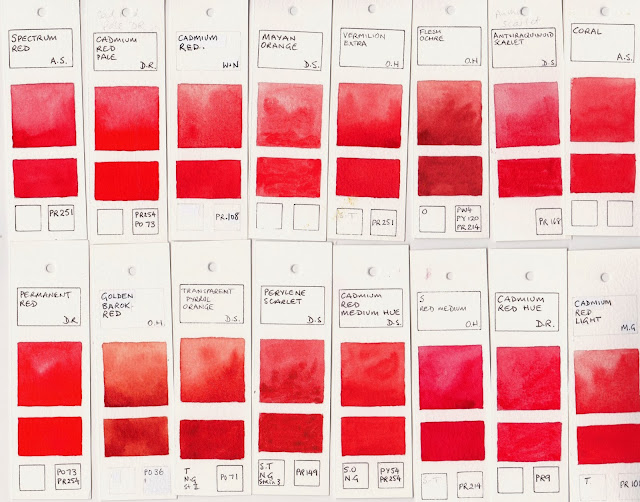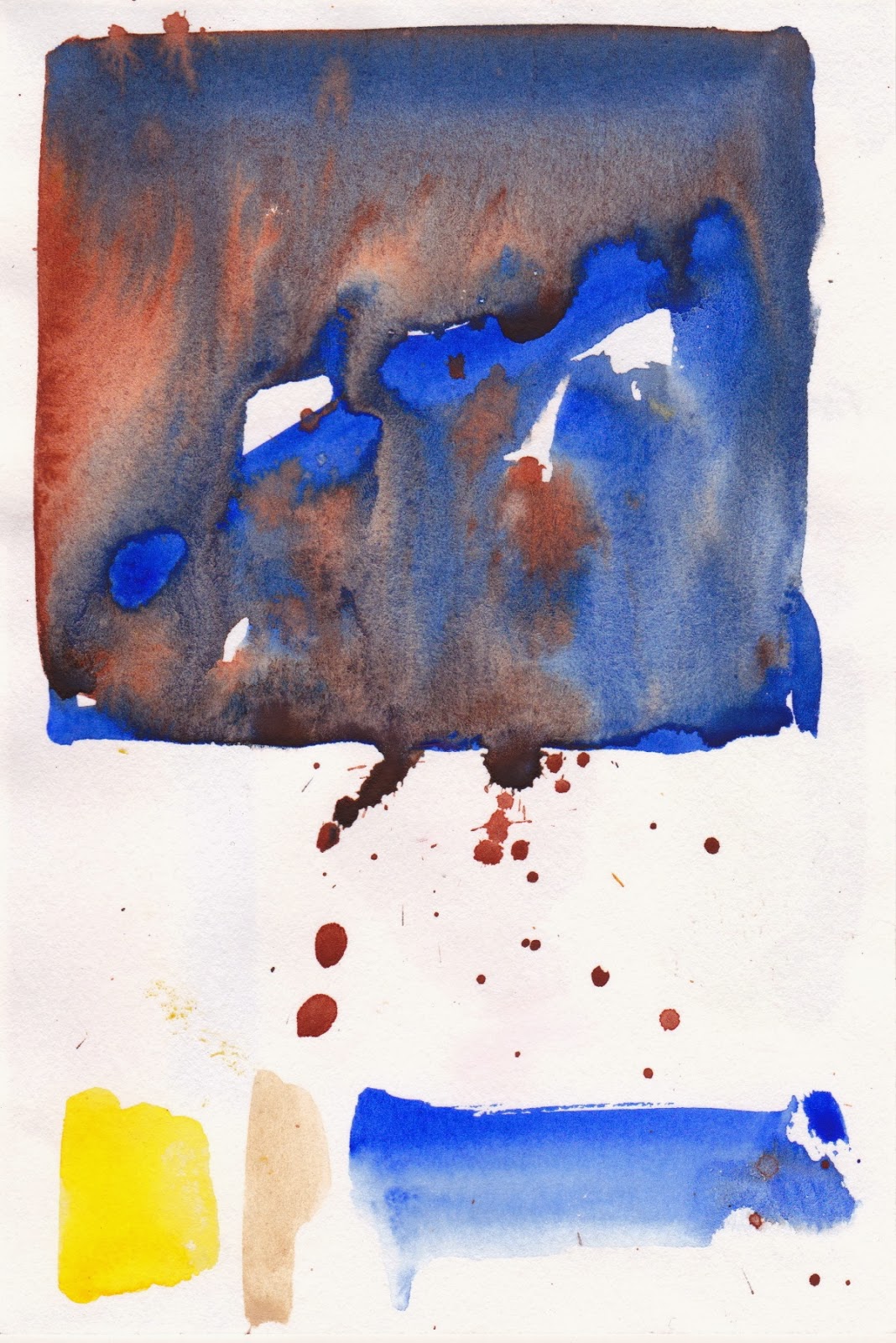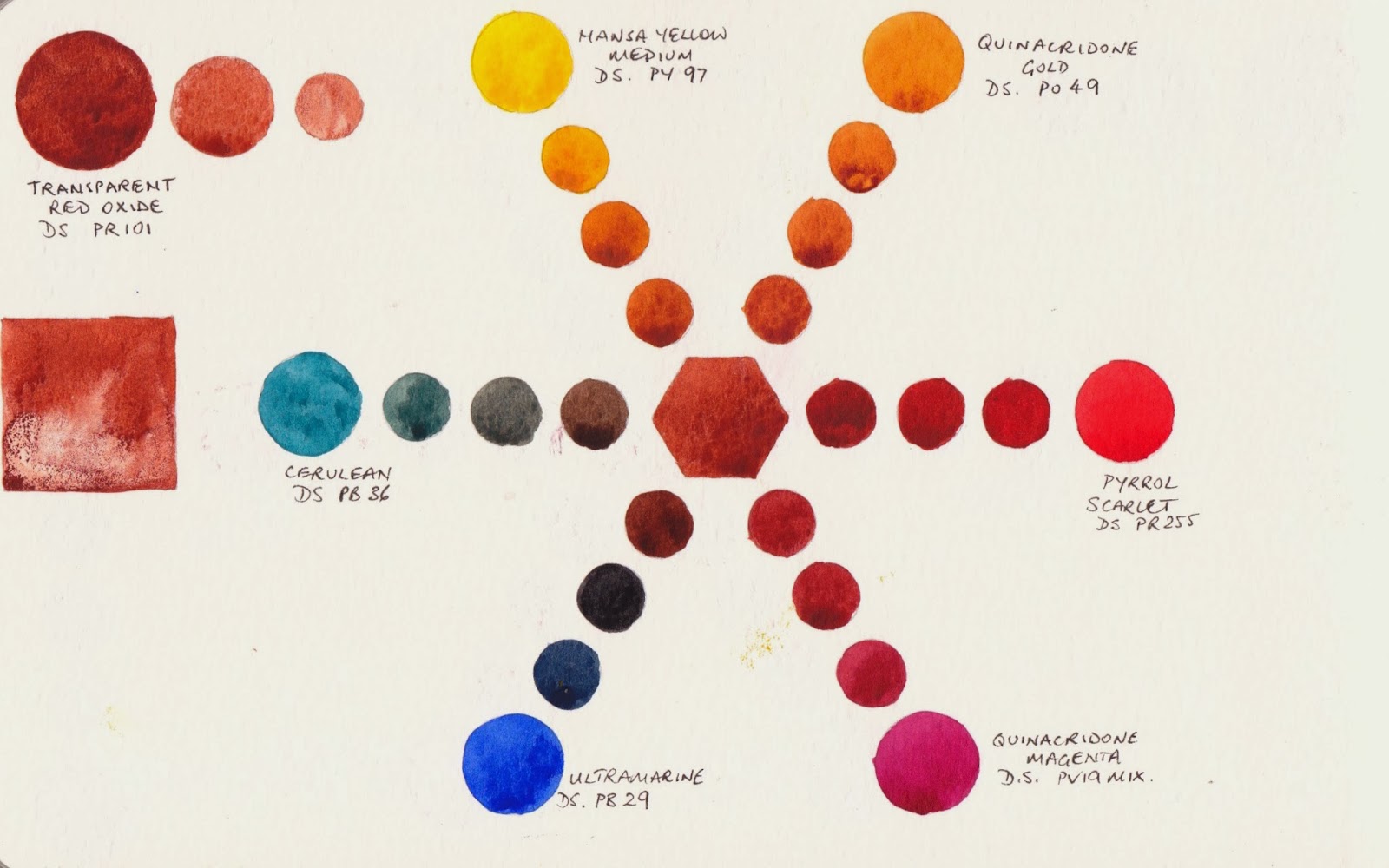I have previously written about choosing a primary red - one that can stand alone in a primary triad of red, yellow and blue. In a limited palette of up to 7 colours I would choose Carmine, by Daniel Smith, as it will mix to make oranges and purples.
But I like to have a few different reds in my palette. I have added all these red swatches, and more, to my website
here.
If I had two reds in a larger palette of perhaps 12 colours I would use Pyrrol Scarlet as a warm and Carmine as a cool. The Pyrrol Scarlet could mix with a blue to create an indian red hue.
If I had three reds in a palette of 15 or 16 colours, I would add Indian Red, and I would switch the warm red to Transparent Pyrrol Orange, though Pyrrol Scarlet is a wonderful colour, and is my recommended warm red option.
My four reds in a 20 colour palette would be Pyrrol Crimson and Quinacridone Rose instead of Carmine, along with Transparent Pyrrol Orange and Indian red. So the reds I choose depend on how many colours I have and how much each individual colour has to do in the palette.
So how do you choose your reds? Generally, one warm and one cool red are useful in the palette, though some like to have a mid 'fire engine' red as well. The warm red will mix to make wonderful bright oranges. The cool red will mix to create purples. If you choose to have an orange in your palette you may choose a mid red to spread your colours over the spectrum further. All the colours in your palette need to work together, so if you make a choice about one colour, it dictates other choices to a large degree. I generally like to have a warm red (or orange red), a crimson AND a rose red for mixing purples. With those 3 reds I can intermix with yellows and blues to make a huge range of oranges, mid reds and purples.
Now I'd like to look a little more at reds in general and show some comparisons.
Warm and mid reds
Here is a comparison of a range of warm (or orange-biased) reds and mid reds. Sadly it is difficult to reproduce reds and oranges accurately so a more useful idea of the actual colour might be found on individual manufacturer's websites. Most of the samples are single pigment colours, which is my preference, but some are a mixture. There are a huge number to choose from, and generally the key is do you want a transparent or opaque red? Do you want warm with a definite orange bias or mid red? Do you want a particular brand? do you want a staining red?
I don't have a problem mixing one brand with another, it's really about what brand you can get hold of most easily and most affordably. Make sure you look at the tube size when buying to compare the price per gram or ounce, but keep in mind that artist quality watercolour lasts a very long time so while a colour you love may cost a bit when you buy it, you may still be using the same tube 15 years later! Unless you are doing a lot of flower painting, you may find you get through your warm reds fairly slowly too, so a smaller tube is fine.
I tend to favour the Pyrrol reds for transparent colours and have Pyrrol Scarlet DS or Transparent Pyrrol Orange DS as my warm red options. If I want a true bright mid red I have a pan of Pyrrol Red in my studio, but I could equally mix this as a hue. MG Naphthol red and DV Naphthol red, though made from different pigments, also both work well as a mid red that mixes beautiful oranges. If I want an opaque red I'd go with Cadmium Scarlet or Cadmium Medium and most brands are fine. Cadmiums are expensive though, so only buy them if you really want the creamy opaque characteristics. Do note that Cadmiums are more toxic than many other pigments so don't let your cat drink your paint water!
You can see some degree of granulation in some of the samples below and they all painted out fairly well except the Mayan Orange, which I didn't like. I painted it from a very small dry sample, but as I always squeeze out my paints into a palette and let them dry, it didn't work for me. (Winsor Red is another popular option if you are looking at W&N watercolours - pictured in the cool reds section below, along with the lovely DS Permanent Red. Whoops!)
 |
Spectrum Red AS, Cadmium Red Pale DR, Cadmium Red W&N, Mayan Orange DS, Vermilion Extra OH, Flesh Ochre, OH, Anthraquinoid Scarlet DS, Coral AS
Permanent Red RR, Golden Barok Red OH, Transparent Pyrrol Orange DS, Perylene Scarlet DS, Cadmium Red Hue DS, Scheveningen Red Medium OH, Cadmium Red Hue DR, Cadmium Red Light MG. |
 |
| Pyrrol Red DS, Naphthol Red DV, Pyrrol Scarlet DS, Cadmium Red Scarlet DS, Naphthol Red MG, Organic Vermilion DS, Bright Red OH, Scheveningen Red Light OH. |
Cool Reds
The many cool reds, or purple biased reds, are often variations of an Alizarin Crimson hue, since Alizarin Crimson PR83 is fugitive and certainly not recommended. Carmine by DS, mentioned above, is one of my favourites for a primary or single pigment red. W&N Permanent Alizarin also works well for this purpose. I also like the DS Permanent Alizarin as a deeper crimson but it is a mixture of three pigments, so I use DS Pyrrol Crimson.
The deep Perylene Maroons are an interesting and popular option too. Some use Perylene maroon + Quin Rose to create a more permanent alizarin crimson hue of their own. I tend to add a touch of phthalo green PG7 to my Pyrrol crimson to create these deeper maroons but they can be convenient for shadow colours.
While the traditional purpose of a cool red is to make purples, I generally find a rose or magenta makes clearer and more beautiful purples so I use crimson as a convenience colour and add a rose to my palette for making purples and pinks.
These painted out very well so the thing to watch is how many pigments are in the colour and how permanent they are. I love the colour of DS Permanent Red Deep but closer inspection of the pigment eliminated it from my palette as the light-fast of that specific version of PR170 is not good enough. It's a shame as it is another great primary red colour, but only if it is in a sketchbook or for reproduction, not for framing or sale.
 |
Permanent Alizarin DS, Carmine DS, Anthraquinoid Red DS, Pyrrol Crimson DS, Perylene Red DS, Winsor Red W&N (a warm red), Permanent Red DS (a mid red)
Permanent Alizarin Crimson W&N, Alizarine Crimson (Quinacridone) DV, Permanent Red Deep DS, Alizarin Crimson DS, Alizarin Crimson W&N, Perylene Red DR, Napthalmide Maroon DS, Perylene Maroon DS. |
Pinks and Roses
If you are adding a pink or rose to your palette there are a number of options. I'd steer clear of the fugitive Rose Madder and Opera Rose/Pink though. I'd also keep away from DS Rhodonite as it changed colour in my light fastness tests.
For general use is it hard to go past PV19 - Quinacridone Rose/Permanent Rose. This pigment is ASTM II rated and makes lovely purples with almost any blue. PV19 seems to be a very versatile pigment. It comes in a rose version and a violet version and will be found in Alizarin Crimson hues, permanent rose, quinacridone rose, quinacridone red (not to be confused with the W&N Quinacridone Red made with PR209), quinacridone violet, red rose deep and so on. It covers a range from a gorgeous rose pink to a rose crimson to a violet. Choose one that you like on its own first, and then make sure you also like the way it mixes. A rose colour is lovely in florals and sunsets and is useful for portraiture as well.
I like DS Quinacridone Rose, DV Permanent Rose Quinacridone, DV Red Rose Deep Quinacridone (which I have as a huge 37ml tube) and the MG Quinacridone Rose, except that this colour, like all in the MG range, is best for the studio as it doesn't 'set' or dry.
Potter's Pink PR233 is an interesting granulating dusty pink - lovely but of limited use. I have this as an occasional use pan just in case, but wouldn't recommend it as a 'must have' colour.
The other lovely option for a cool red for mixing purples is a magenta, which will be covered in a later post - Watercolour Comparisons 13 - Purples. Most of the samples painted out well except the Mayan Red. I tend to avoid the multi-pigment Holbein colours too - this one has white in the mix.
 |
Quinacridone Red W&N, Quinacridone Coral DS, Mayan Red DS, Rose Dore W&N, Shell Pink Holbein, Rhodonite Genuine DS, Potter's Pink DS, Rose Madder Genuine DS
Quinacridone Red DS, Permanent Rose W&N, Permanent Rose (Quinacridone) DV, Quinacridone Rose MG, Quinacridone Pink DS, Rose Red Deep (Quinacridone), Opera Pink DS, Opera Rose W&N. |
So there is a vast range of reds to consider. You can probably manage very well with 2, 3 or 4 of them depending on the size of your palette and what you paint, and perhaps a fun one for special effects. Remember to check the light fast rating of all you buy, and make sure your colours interact and mix nicely together.
I will compare earth reds in a separate post - Watercolour Comparisons 11 Earth Reds.
Watercolour Comparisons 1 - Ultramarine Blue
here
Watercolour Comparisons 2 - mid yellows
here
Watercolour Comparisons 3 - Primary Red
here
Watercolour Comparisons 4 - Burnt Sienna
here
Watercolour Comparisons 5 - Greens (Single Pigment, convenience mixes and special effect)
here
Watercolour Comparisons 6 - Reds (Cool, mid and warm)
here
Watercolour Comparisons 7 - Yellows (cool mid and warm)
here
Watercolour Comparisons 8 - Blues
here



































